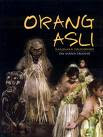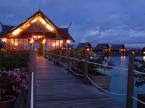Thursday, November 19, 2009
Orang Asli
Posted by IDA.. at 12:47 AM 0 comments
local food
Local food (also regional food or food patriotism) or the local food movement is a "collaborative effort to build more locally based, self-reliant food economies - one in which sustainable food production, processing, distribution, and consumption is integrated to enhance the economic, environmental and social health of a particular place" and is considered to be a part of the broader sustainability movement. It is part of the concept of local purchasing and local economies, a preference to buy locally produced goods and services. Those who prefer to eat locally grown/produced food sometimes call themselves locavores or localvores.
The definition of "local" or "regional" is flexible and is different depending on the person in question. Some local business with specific retail and production focuses, such as cheese, may take a larger view of what is 'local' while a local farm may see the area with in a day's driving as local because it is a reasonable distance to transport goods and services. Some see "local" as being a very small area (typically, the size of a city and its surroundings), others suggest the ecoregion or bioregion size, while others refer to the borders of their nation or state.Local food is, by definition, food produced locally. Whether the seed - an integral part of the "food" - was grown or procured locally as well is usually left out of this definition, leading to even greater ambiguity as to its meaning. Many local food proponents tend to equate it with food produced by local independent farmers, while equating non-local food with food produced and transformed by large agribusiness. They may support resisting globalization of food by pressing for policy changes and choosing to buy local food. They may also follow the practice of the boycott or buycott.
Another effect is the increase in food quality and taste. Locally grown fresh food is consumed almost immediately after harvest, so it is sold fresher and usually riper (e.g. picked at peak maturity, as it would be from a home garden). Also, the need for chemical preservatives and irradiation to artificially extend shelf-life is reduced or eliminated.
Posted by IDA.. at 12:16 AM 0 comments
Wednesday, November 18, 2009
King of fruits
-King of fruits in Malaysia-
The durian is the fruit of several tree species belonging to the genus Durio and the Malvaceae family (although some taxonomists place Durio in a distinct family, Durionaceae). Widely known and revered in Southeast Asia as the "king of fruits", the durian is distinctive for its large size, unique odour, and formidable thorn-covered husk. The fruit can grow as large as 30 centimetres (12 in) long and 15 centimetres (6 in) in diameter, and it typically weighs one to three kilograms (2 to 7 lb). Its shape ranges from oblong to round, the colour of its husk green to brown, and its flesh pale yellow to red, depending on the species.
The name durian comes from the Malay word duri (thorn) together with the suffix -an (for building a noun in Malay). D. zibethinus is the only species commercially cultivated on a large scale and available outside of its native region. Since this species is open-pollinated, it shows considerable diversity in fruit colour and odour, size of flesh and seed, and tree phenology . In the species name, zibethinus refers to the Indian civet, Viverra zibetha. There is disagreement regarding whether this name, bestowed by Linnaeus, refers to civets being so fond of the durian that the fruit was used as bait to entrap them, or to the durian smelling like the civet.
Posted by IDA.. at 10:27 PM 0 comments
Monday, November 16, 2009
cartoon
The original meaning was in fine art, and there cartoon meant a preparatory drawing for a piece of art such as a painting or tapestry.
Cartoon Network is an American cable television network created by Turner Broadcasting which primarily shows animated programming. The channel began broadcasting on October 1, 1992. Cartoon Network can also refer to the studio which produces original shows for the network.
-Cartoon Anime-
Anime an abbreviated pronunciation in Japanese of "animation", pronounced [anime] in Japanese, but typically in English is animation originating in Japan. The world outside Japan regards anime as "Japanese animation". Anime originated about 1917.
Anime, like manga (Japanese comics), has a large audience in Japan and high recognition throughout the world. Distributors can release anime via television broadcasts, directly to video, or theatrically, as well as outline.
Both hand-drawn and computer animated anime exist. It is used in television series, films, video, video games, commercial, and internet-based releases, and represents most, if not all, geners of fiction. Anime gained early popularity in East and Southern Asia and has garnered more-recent popularity in the Western world.
Posted by IDA.. at 12:09 AM 0 comments
Saturday, November 7, 2009
Bali Indonesia
Bali is an Indonesian island located at the westernmost of the Lesser Sunda Islands, lying between Java to the west and Lombok to the east. It is one of the country's 33 provinces with the provincial capital at Denpasar towards the south of the island.
A spectacular 40 metres of crystal clear water rushing headlong into a seemingly bottomless pool that tempts visitors with a tantalisingly refreshing swim.
But should you decide to succumb to the charms of the falls, beware; but not of any physical danger - local legend has it that couples who bath together at the lovely pools will eventually separate.
Posted by IDA.. at 7:36 PM 0 comments
Wednesday, November 4, 2009
Amazon Rainforest

-Exotic birds-
kinds of birds amidst the luscious green forest.
Posted by IDA.. at 11:06 PM 0 comments
Friday, October 30, 2009
Italy
The origin of the term Italia, from Latin : Italia, is uncertain. According to one of the more common explanations, the term was borrowed through Greek from the Oscan Víteliú, meaning "land of young cattle" (cf. Lat vitulus "calf", Umb vitlo "calf"). The bull was a symbol of the southern Italian tribes and was often depicted goring the Roman wolf as a defiant symbol of free Italy during the Samnite Wars.
Milan is divided into 9 distinct zones that radiate out from the Historical Center (Zona 1) to the periphery. They are identified numerically by the local council, but also have names, and each zone includes many different neighborhoods and quarters. Although every area is not listed here, each plays its own special role in the history of Milan; from the importantissimo historical center to the modern "dormitory quarters" of San Siro.
Posted by IDA.. at 11:13 PM 0 comments
Thursday, October 15, 2009
Taj Mahal
The Taj Mahal (also "the Taj") is considered the finest example of Mughal architecture , a style that combines elements from Persian, Indian, and Islamic In 1983, the Taj Mahal became a UNESCO World Heritage Site and was cited as "the jewel of Muslim arts in India and one of the universally admired masterpieces of the world's heritage." architectural styles.
While the white domed marble mausoleum is its most familiar component, the Taj Mahal is actually an integrated complex of structures. Building began around 1632 and was completed around 1653, and employed thousands of artisans and craftsmen. The construction of the Taj Mahal was entrusted to a board of architects under imperial supervision including Abd ul-Karim Ma'mur Khan, Makramat Khan, and Ustad Ahmad Lahauri. Lahauri is generally considered to be the principal designer.
Taj Mahal mosque or masjid
The Taj Mahal was built on a parcel of land to the south of the walled city of Agra. Shah Jahan presented Maharajah Jai Singh with a large palace in the center of Agra in exchange for the land. An area of roughly three acres was excavated, filled with dirt to reduce seepage, and leveled at 50 meters above riverbank. In the tomb area, wells were dug and filled with stone and rubble to form the footings of the tomb. Instead of lashed bamboo, workmen constructed a colossal brick scaffold that mirrored the tomb. The scaffold was so enormous that foremen estimated it would take years to dismantle. According to the legend, Shah Jahan decreed that anyone could keep the bricks taken from the scaffold, and thus it was dismantled by peasants overnight. A fifteen kilometer tamped-earth ramp was built to transport marble and materials to the construction site and teams of twenty or thirty oxen pulled the blocks on specially constructed wagons. An elaborate post-and-beam pulley system was used to raise the blocks into desired position. Water was drawn from the river by a series of purs, an animal-powered rope and bucket mechanism, into a large storage tank and raised to a large distribution tank. It was passed into three subsidiary tanks, from which it was piped to the complex.
Posted by IDA.. at 8:59 PM 0 comments
Wednesday, October 14, 2009
Sipadan Island
-Welcome to Sipadan Island-
Pulau Sipadan Island was at the top of Rodale's Scuba Diving Magazine Gold List for 'The Top Dive Destination in the World'. In fact the island shared its top spot with 2 other destinations known for the amazing diversity of their marine life - the Galapagos Islands and Truk in Micronesia.
The list of attractions is quite staggering and all the more exceptional as it involves plenty of big fish encounters - barracudas, large schools of trevally and marauding bumphead parrotfish. This is one of the big fish capitals of the world.
Resort facilities include: restaurant and bar - pool table - board games - darts - table tennis - beach volleyball - sea canoes - international telephone and facsimile - internet access including personal laptop connectivity - baby sitting - sun deck - gift shop
Sipadan Kapalai Resort
Posted by IDA.. at 11:52 PM 0 comments




















































